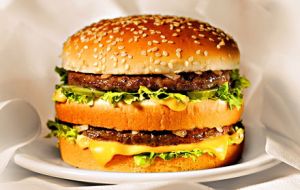MercoPress. South Atlantic News Agency
Venezuelan currency overvalued by 83% according to the Big Mac index
 Why not a Big Mac in Moscow, it’s far cheaper
Why not a Big Mac in Moscow, it’s far cheaper The Big Mac index computed by The Economist showed that the Venezuelan Bolivar is the most overvalued currency worldwide with respect to the US dollar, reflecting the imbalance of the Venezuelan economy.
The Big Mac index is based on the purchasing-power parity theory which provides that the exchange rate between two currencies is balanced when the price of a single product is the same in both countries. For such reference, a Big Mac burger is commonly used.
By contrasting the Venezuelan and the Russian currencies at the current exchange rate a Big Mac Burger, which costs 4.33 dollars in the US, costs 2.29 dollars in Russia and 7.92 dollars in Venezuela, which shows that the Venezuelan currency is overvalued.
According to the index, overvaluation of the Venezuelan currency stood at 83% by the end of July.
An overvalued currency implies that exports lose ground as goods manufactured in Venezuela are more expensive for the rest of the world. Meanwhile, imports continue growing as prices are low.
Such disparity is the result of an official fixed exchange rate that has stood at 4.30 Bolivares per US dollar, while the Venezuelan inflation, even when it has been easing, is globally among the highest. In the parallel or black market the greenback is traded at almost double the official rate.
However the big question is what can be expected for next year when the October presidential election is over and as public opinion polls anticipate President Chavez is re-elected, particularly government over-spending to ensure victory.
Nomura analyst Boris Segura said he expects the fixed rate to be depreciated 51% and an economic contraction of 1% next year. Bank of America’s Merrill Lynch is even more pessimistic, forecasting 74% devaluation and a GDP loss of 3.5%.
The Chavez administration will need a correction to the exchange rate to help it meet its ever-growing list of expenditures on state projects and programs, and narrow its fiscal deficit, which Barclays estimates will reach 19.5% of GDP by the end of 2012, compared with 5% just four years ago.




Top Comments
Disclaimer & comment rules-

-

-

Read all commentsGuys, you got a new way to measure us, the Big Mac index! Hahahahahaha
Aug 09th, 2012 - 07:46 am 0I can remember when the item of comparison was the Mars Bar .... The Mars Bar Index of purchasing power parity. What happened to the MBIOPPP?
Aug 09th, 2012 - 09:34 am 0@1 It's not exactly “new”. It was originally introduced in September 1986. Perhaps you should try to keep up! Incidentally, another index is the Starbucks tall latte index.
Aug 09th, 2012 - 11:41 am 0Commenting for this story is now closed.
If you have a Facebook account, become a fan and comment on our Facebook Page!